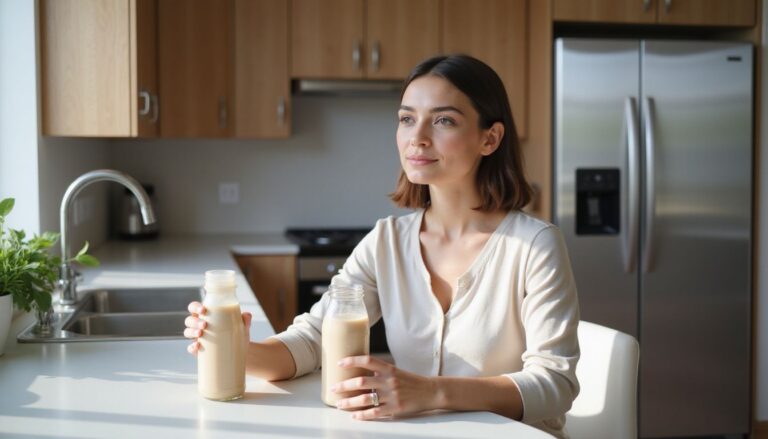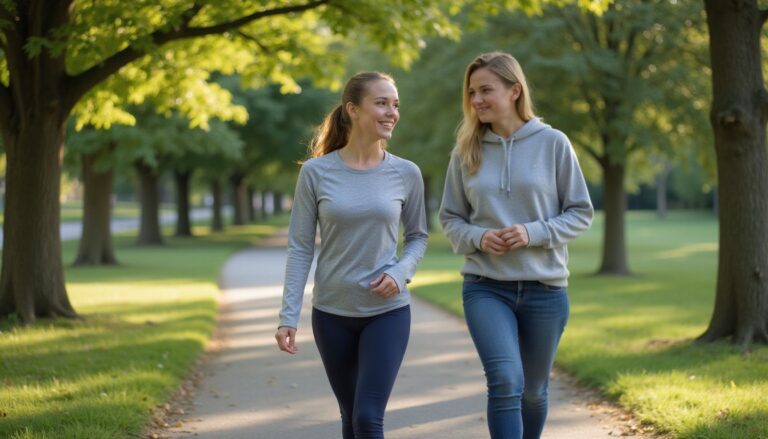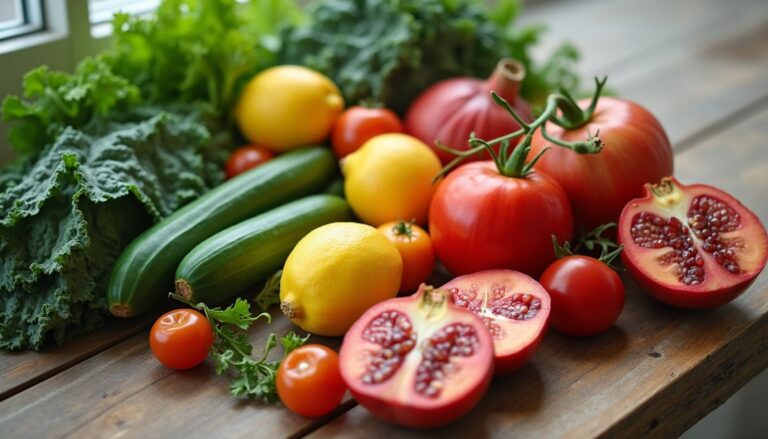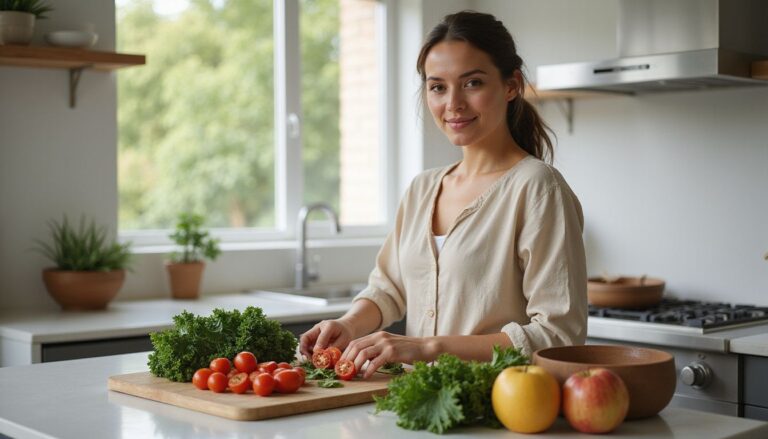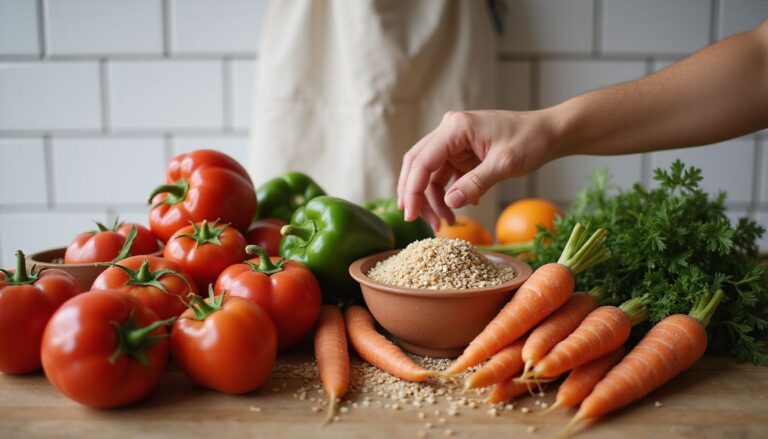Effective Clean Eating Plan For Weight Loss: Meal Plan And Calorie Guide For Better Health
Our Nutrition Assistant AI Suite will transform your body. You will lose fat, get toned, and build muscle. Gain confidence and optimal health.
You work hard to eat healthy yet the scale barely moves. A clean-eating meal plan can lower calories while raising nutrition, which helps with steady weight loss and better health. In this guide, you will get a simple plan created with dietitian input, smart whole-food swaps, and a clear calorie roadmap you can follow without stress.
Use these ideas to build habits that fit your life. Small changes add up when you repeat them day after day.
Key Takeaways
- Clean eating centers on whole, minimally processed foods while limiting added sugar, refined grains, and unhealthy fats for sustainable weight loss and better health.
- A 7-day clean-eating meal plan averages about 1,500 to 1,600 calories with at least 72 grams of protein and 30 grams of fiber per day.
- The Mayo Clinic Diet’s “LOSE IT!” phase reports 6 to 10 pounds lost in two weeks by practicing whole-food habits and portion control.
- Meal prep and batch cooking can improve follow-through on nutrition goals by up to 50% (International Journal of Behavioral Nutrition and Physical Activity, 2017).
- Estimate daily calorie needs using age, sex, weight, height, and activity. Most adults start near 1,500 calories for weight loss, and should not go below 1,200.
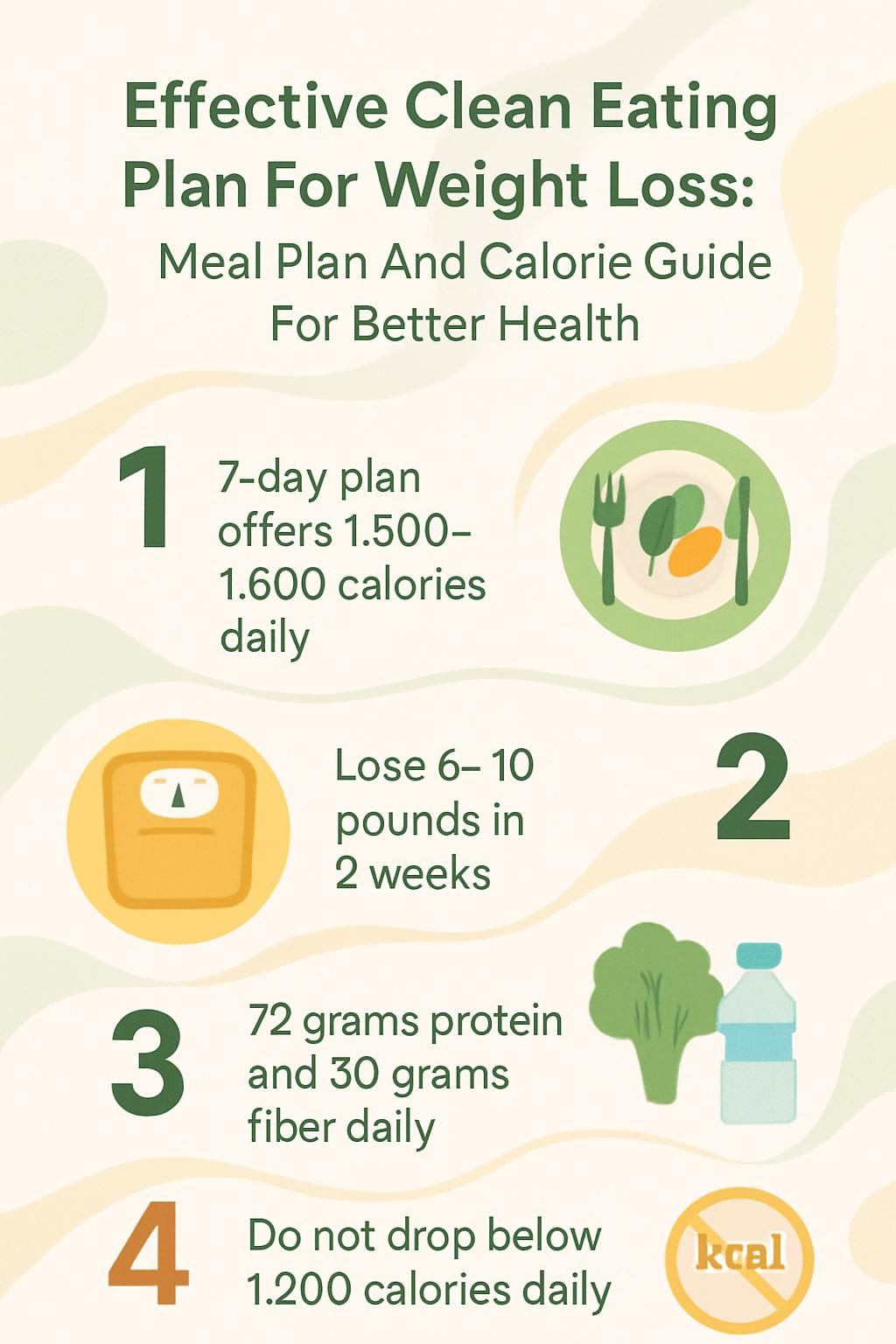
What Is Clean Eating?
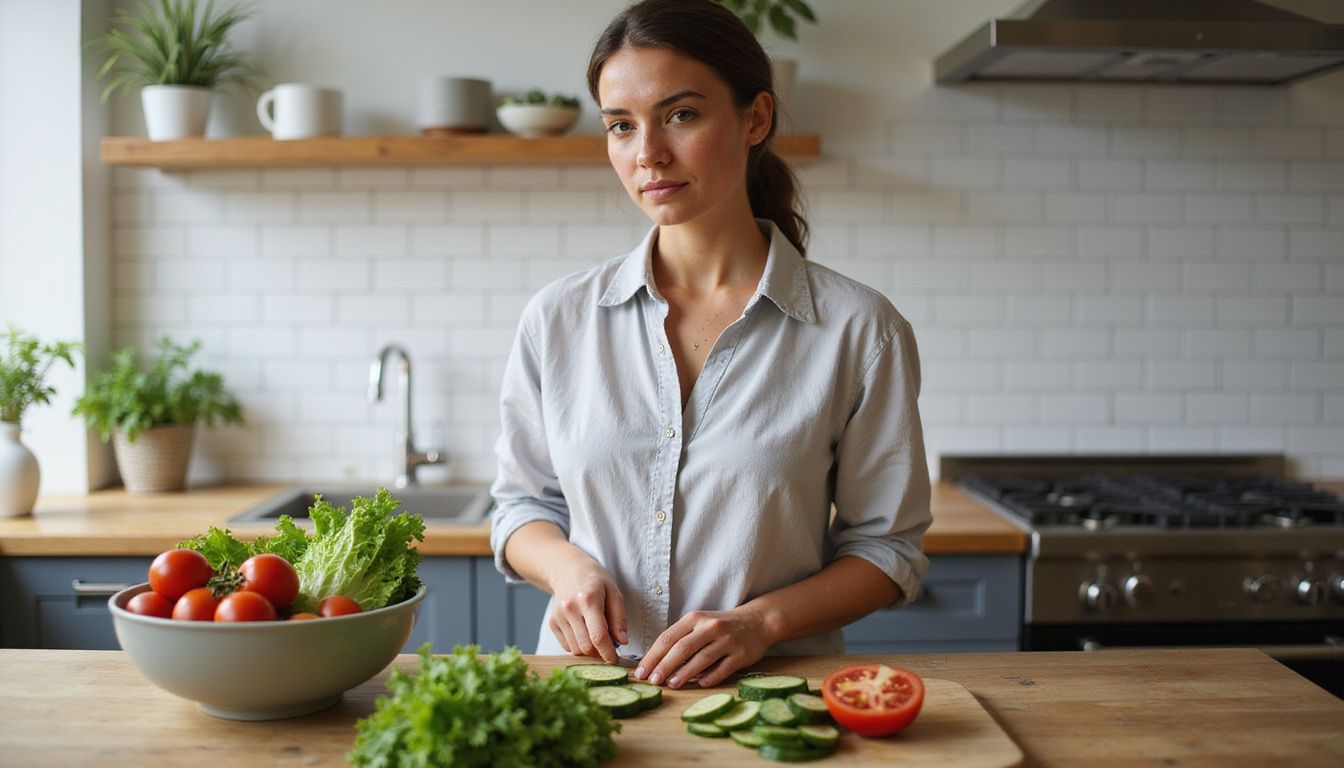
Clean eating means choosing foods close to their natural state. Think fresh produce, whole grains, lean protein, and healthy fat. This style helps you meet daily nutrient needs while managing calories for weight control.
What are the core principles of clean eating?
Build meals with fruits and vegetables, lean proteins like chicken or tofu, healthy fats from nuts or olive oil, and whole grains such as brown rice and oatmeal. Limit products with long ingredient lists, added sugars, refined grains, and trans fats.
Balance matters. Pay attention to hunger and fullness, not just calories. Allow room for flexible swaps or a small treat so the plan stays livable.
Choose minimally processed options at each meal or snack. Pick brown rice or quinoa instead of white rice. Swap candy for an orange or banana. Reach for unsalted dry-roasted almonds rather than chips.
The 2020 to 2025 Dietary Guidelines for Americans emphasize nutrient-dense choices. That means fiber, vitamins, minerals, and adequate protein while keeping calories in check.
A healthy diet starts by choosing food in its most natural form.
Why are minimally processed foods important?
Minimally processed foods keep more fiber, vitamins, and minerals than heavily processed items. Food databases used by registered dietitians, such as ESHA, show whole foods often deliver more nutrition per bite.
A bowl of oats made from whole rolled oats has fewer added sugars than many instant packets. Fresh produce supports your plan, and it helps you skip artificial sweeteners and preservatives found in many snacks.
When I shifted to whole grains like brown rice instead of refined grains, I felt full longer and had more steady energy through the day. That made healthier eating easier to maintain.
Benefits of Clean Eating for Weight Loss
Clean eating is not a crash diet. It creates a repeatable routine that supports weight loss and better health one meal at a time.
How does clean eating promote sustainable weight loss?
Whole foods reduce sneaky calories and keep you satisfied. The Mayo Clinic Diet’s “LOSE IT!” phase teaches five positive habits, five to stop, and five bonus habits. Many people lose 6 to 10 pounds in two weeks, then continue at about 1 to 2 pounds per week in the “LIVE IT!” phase.
Base meals on vegetables, lean protein such as fish or skinless chicken, and healthy fats like nuts or olive oil. This keeps calories controlled while staying filling.
Fruits and vegetables supply slow-digesting carbs and fiber, which helps stabilize blood sugar. That supports long-term change, not quick fixes.
The Mediterranean diet is recommended for balance and supports sustainable weight loss through steady lifestyle changes.
How does clean eating support digestion and gut health?
Whole grains, legumes, and vegetables help you eat at least 30 grams of fiber daily. Fiber supports a healthy gastrointestinal tract and more regular bowel movements.
Foods like spinach, cucumber, beans, and brown rice feed good gut bacteria. These bacteria produce short-chain fatty acids that support the colon lining and may lower inflammation.
Raise fiber slowly to limit temporary bloating. Many people also feel better with low-fat dairy options such as cottage cheese or nonfat strained yogurt.
Can clean eating increase energy and mental clarity?
Balanced meals with whole grains, lean protein, and healthy fats support steady blood sugar. Stable blood sugar reduces energy crashes and helps your brain stay sharp.
Aim for at least 72 grams of protein from eggs, fish such as tuna or salmon, skinless poultry, tofu, or beans. Protein supports steady energy for both body and mind.
Cutting added sugars and ultra-processed foods may reduce focus dips or mood swings. When I added more vegetables, fruit, and lean proteins, afternoon mental clarity improved without extra coffee.
How does clean eating reduce cravings for unhealthy foods?
Removing processed snacks and sugary drinks helps curb cravings. Whole foods, like fruit, vegetables, lean meats, and natural peanut butter, are rich in nutrients and fiber. They help you feel full on fewer calories.
Stable blood sugar makes a big difference. Meal prep with ready-to-eat items, such as hummus with sliced cucumbers or carrots, keeps you on track when hunger strikes.
Planning helped me most at breakfast. Eggs as food on my menu lowered my urge for sugary cereal. Diets lower in sodium and refined grains also support heart health and reduce overeating.
Key Guidelines for a Clean Eating Plan
These simple rules keep your choices clear. Focus your cart on whole foods and keep portions reasonable at every meal.
Why focus on whole, unprocessed foods?
Whole foods deliver more nutrition per calorie. Pick a sweet potato over chips or an orange instead of a sugary juice drink.
Nutrition labels now list added sugars. Use them to spot better choices quickly. Processed foods often bring extra sodium and unhealthy fats that raise blood pressure and heart risk.
Choose vegetables, fruits, whole grains like brown rice or couscous, lean proteins such as a veggie burger or chicken breast, and healthy fats from walnuts or olive oil. These choices offer steady energy and fewer cravings.
Since processed snacks often pack empty calories, an average 1,500-calorie day built on whole foods supports weight loss with enough fiber, vitamins, and minerals to stay full between lunch and dinner.
What foods should be avoided, like added sugars and refined grains?
Limit added sugars from soda, candy, sweetened yogurt, and pastries. Many people consume about 17 teaspoons of added sugar daily. The American Heart Association suggests no more than 6 teaspoons for women and 9 for men.
Skip sugary sauces and dressings that add hidden calories. Avoid refined grains in white bread, hamburger buns, crackers, white rice, and many baked goods. Processed meats can include preservatives and trans fats that raise blood pressure risk.
Switching toast from white to whole-grain helped keep my morning energy steady. Keeping easy and delicious recipes in the refrigerator that avoid artificial sweeteners also reduces cravings on the busiest days.
Which lean proteins and healthy fats should you prioritize?
Choose chicken, fish, tofu, and legumes at each meal. This helps you reach 67 to 100 grams of protein, which protects muscle during weight loss.
Use beans in soup, add grilled chicken to salads with tomato and leafy greens, or try tofu in stir-fries. For healthy fat, pick avocado, olive oil, and nuts. A tablespoon of olive oil on roasted vegetables adds flavor and satisfaction.
Most people do well with about 67 to 89 grams of total fat per day from whole-food sources. I often mash avocado for creaminess in recipes instead of heavy cream.
How much water and herbal teas should you drink?
Aim for at least eight 8-ounce glasses of water daily. Exercise or hot weather increases your needs.
Replace sugary drinks with water or unsweetened herbal teas such as mint, chamomile, or rooibos. A reusable bottle nearby makes it easy to keep sipping through the day. Milk counts toward fluids, yet water and herbal tea work best for most people.
Sample 7-Day Clean Eating Meal Plan
This 7-day plan shows what clean eating looks like on your plate. Use it as a template, then adjust portions to reach your calorie goal.
What does Day 1 look like for breakfast, lunch, dinner, and snacks?
Day 1 sets the tone with balanced meals that satisfy and support weight loss.
- Breakfast: Greek yogurt with fresh berries and a sprinkle of chia seeds for protein and fiber.
- Lunch: Grilled chicken over mixed greens with cherry tomatoes and cucumber, plus light olive oil vinaigrette.
- Dinner: Salmon with roasted red pepper quinoa salad for lean protein, healthy fats, and slow-digesting carbs.
- Snacks: Baby carrots or apple slices with almond butter to curb cravings without added sugar.
- Beverages: Water or unsweetened herbal tea to support digestion and metabolism.
- Daily total: About 1,510 calories, 71 g fat, 88 g protein, 135 g carbohydrate, and 30 g fiber.
- Need more calories? Add peanut butter at breakfast or a small handful of almonds or walnuts.
What does Day 2 look like for breakfast, lunch, dinner, and snacks?
Day 2 keeps nutrition steady with simple, high-impact choices that fit a busy day. Total is about 1,507 calories.
- Breakfast: Whole-grain toast with natural peanut butter and sliced banana or berries.
- Morning snack: A small handful of walnuts for heart-healthy fats.
- Lunch: Avocado salad with leafy greens, cherry tomatoes, cucumber, grilled chicken, and fresh lemon.
- Afternoon snack: One apple or orange for fiber and natural sweetness.
- Dinner: Baked salmon or tofu with steamed broccoli and cooked brown rice for protein and complex carbs.
- Hydration: Aim for at least eight cups of water.
- Evening: Enjoy herbal tea as a caffeine-free option to wind down.
Macros: About 89 g fat, 80 g protein, 111 g carbohydrate, and 32 g fiber. I also noticed less bloating and better fullness with this layout.
What does Day 3 look like for breakfast, lunch, dinner, and snacks?
Day 3 focuses on fiber and flavor to support energy and appetite control.
- Breakfast: Oatmeal with sliced strawberries and chia seeds for long-lasting energy.
- Morning snack: One apple with one tablespoon natural almond butter.
- Lunch: Grilled chicken salad with spinach, cherry tomatoes, cucumber, avocado, olive oil, and lemon.
- Afternoon snack: Carrot sticks with hummus for fiber and plant protein.
- Dinner: Southwestern Cauliflower Rice Bowls with sautéed shrimp and avocado crema.
- Evening snack: Fresh berries to satisfy a sweet tooth with antioxidants.
- Daily total: About 1,510 calories, 79 g fat, 76 g protein, 132 g carbohydrate, and 31 g fiber.
- Need extra calories? Add walnuts at breakfast or a side salad at lunch or dinner.
- Hydration: Sip water and herbal teas such as peppermint or green tea through the day.
- Planning meals ahead keeps nutrition on track and reduces the pull of processed snacks.
Day 3 supports muscle recovery while keeping cravings low through balanced, whole-food meals.
What does Day 4 look like for breakfast, lunch, dinner, and snacks?
Day 4 emphasizes lean protein, produce, and balanced macros. Total is about 1,507 calories, 75 g fat, 95 g protein, 126 g carbohydrate, and 30 g fiber.
- Breakfast: Oatmeal cooked with unsweetened almond milk, topped with blueberries and chia.
- Lunch: Grilled chicken breast on a large garden salad with mixed greens, tomatoes, cucumber, and avocado.
- Snack: Greek yogurt with sliced strawberries and a small handful of walnuts.
- Dinner: Baked salmon with roasted sweet potatoes and steamed broccoli.
- Hydration: Water through the day, plus unsweetened herbal tea as desired.
- Higher calorie needs? Add whole-grain toast, raw almonds, or a side of guacamole.
- This setup provides key nutrients while controlling portions for efficient progress.
What does Day 5 look like for breakfast, lunch, dinner, and snacks?
Day 5 maintains variety with easy, repeatable meals. Total is about 1,525 calories, 73 g fat, 72 g protein, and 158 g carbohydrate.
- Breakfast: Overnight oats with rolled oats, almond milk, chia seeds, and blueberries.
- Mid-morning snack: Plain Greek yogurt with sliced strawberries for protein and calcium.
- Lunch: Quinoa salad with grilled chicken, spinach, cherry tomatoes, cucumber, and olive oil.
- Afternoon snack: Carrot sticks with hummus for fiber and plant protein.
- Dinner: Creamy chicken and vegetable pie, about 380 calories per serving, using lean chicken and whole-grain crust.
- Need more calories? Include kefir, a small handful of walnuts, or a side salad.
- Drink at least eight cups of water to support digestion and hydration.
Next comes the Calorie Guide for Weight Loss to help you set daily targets with confidence.
What does Day 6 look like for breakfast, lunch, dinner, and snacks?
Day 6 maximizes nutrient balance with lean protein, whole grains, produce, and healthy fats.
- Breakfast: Oatmeal with blueberries and a drizzle of almond butter for complex carbs and healthy fat.
- Snack: Greek yogurt with sliced strawberries for protein and probiotics.
- Lunch: Grilled chicken over quinoa salad with cherry tomatoes, cucumber, spinach, olive oil vinaigrette, and pumpkin seeds.
- Afternoon snack: Carrot sticks with homemade hummus, low in sodium and rich in fiber.
- Dinner: Baked salmon with roasted sweet potatoes and steamed broccoli for omega-3s and fiber.
- Evening snack: Apple slices with cinnamon or a small handful of raw almonds.
- Daily total: About 1,592 calories, 67 g protein, 185 g carbohydrate with 32 g fiber, 68 g fat, and 1,581 mg sodium.
The next section explains how to calculate your calorie needs and adjust portions for steady results.
What does Day 7 look like for breakfast, lunch, dinner, and snacks?
Day 7 blends fiber, protein, and flavor so you finish the week strong.
- Breakfast: 10-Minute Spinach Omelet, about 350 calories.
- Morning snack: 1/2 cup raspberries, about 48 calories.
- Lunch: Chicken and Apple Kale Wraps, about 400 calories, plus one plum.
- Afternoon snack: 20 almonds and 1 cup blackberries, about 216 calories total.
- Dinner: Grilled Peach and Brie Smothered Chicken with 1 cup quinoa, about 509 calories.
- Daily total: About 1,523 to 1,580 calories, 71 to 73 g fat, 95 g protein, 136 to 177 g carbohydrate, 34 to 36 g fiber, and 1,072 to 1,506 mg sodium.
- Personal note: This lineup kept my evening cravings low and made tracking simple.
Next, learn how to estimate your daily needs and split calories across meals for control and flexibility.
Calorie Guide for Weight Loss
Calories are your budget. Spend them on whole foods so every bite works for you.
How do you calculate daily calorie needs?
Start with age, sex, height, weight, and activity level. A quick estimate for maintenance is weight in pounds times 12 for lightly active adults. A 150-pound woman would need about 1,800 calories to maintain.
Create a daily deficit near 500 calories to lose about one pound per week. Many adults do well starting at 1,500 calories for weight loss. If you are larger or very active, you may need closer to 1,800 to 2,000 calories.
Avoid dropping below 1,200 calories, which can make it hard to meet nutrient needs. I like to check my number with an online calculator, then review meals each week to see what works.
This information is educational. If you have a medical condition, talk with your healthcare provider or a registered dietitian before making big changes.
What is a sample calorie allocation for clean eating meals?
Many clean-eating days set breakfast near 280 to 350 calories, lunch around 400 to 430, and dinner plus snacks to reach the day’s total.
Example: One sample day with salmon and roasted red pepper quinoa salad totals about 1,510 calories with 71 g fat, 88 g protein, 135 g carbohydrate, and 30 g fiber.
Another sample day with Southwestern Cauliflower Rice Bowls is about 1,504 calories with roughly 67 g fat, 100 g protein, and 138 g carbohydrate, plus about 30 g fiber and very low sodium. On Day 7 you might see 1,523 to 1,580 calories depending on portion sizes.
Meal Prep Tips for Clean Eating Success
Meal prep reduces decision fatigue. You will save time and make healthy eating easier on busy days.
How can planning meals in advance help?
Planning ahead saves time, lowers stress, and improves the quality of your choices. People who plan meals tend to eat fewer calories and more nutrient-dense foods.
Prepare salads and snacks in advance, portion nuts for grab-and-go, and batch-cook proteins like chicken or tofu. I make two days of lunches on Sunday, which cuts down fast food stops and keeps energy steady through the week.
What are the benefits of batch cooking?
Batch cooking lets you prepare several dishes in one session. Cook grains, proteins, and vegetables in larger amounts, then mix and match across the week.
Roasted chicken breast can top salads at lunch or pair with quinoa at dinner. Using staples like brown rice, beans, lentils, and nuts makes clean eating faster and more consistent.
Research shows meal prepping can increase adherence to nutrition goals by up to 50% compared with spontaneous cooking. Prepping ahead also lowers weeknight stress, since you only need to reheat and assemble.
What clean eating essentials should you stock in your pantry?
Keep quinoa, brown rice, and oats on hand for simple bases. Stock nuts and seeds like almonds, sunflower seeds, and chia for healthy fats and easy snacks.
Have olive oil for cooking and dressings. Canned fish, dried beans, and lentils provide lean protein. Nut butter adds quick energy when time is short.
Store canned tomatoes, low-sodium broth, and frozen vegetables to build balanced meals fast. Dried herbs and spices add flavor without extra sugar or salt. A well-stocked pantry means a healthy meal is always within reach.
Foods to Include in Your Clean Eating Plan
Fill your plate with nutrient-dense foods that support weight loss and steady energy. Variety keeps meals satisfying and helps you meet goals.
Which fresh fruits and vegetables are best?
Berries, apples, oranges, and pears bring fiber and vitamins. A cup of strawberries supplies about 89 mg of vitamin C. Blueberries add antioxidants that support immune function.
If you need to watch blood sugar, emphasize vegetables over fruit. Leafy greens like spinach and kale are low in calories and rich in nutrients. Bell peppers provide vitamins A and C. Carrots are rich in beta-carotene for eye health.
Mayo Clinic Diet guidance allows generous portions of non-starchy vegetables because they promote fullness with few calories. I like raw celery sticks and sliced cucumber for snacks that crunch without added sodium.
What whole grains like quinoa and brown rice should you eat?
Choose quinoa, brown rice, and 100% whole-grain bread to boost fiber and minerals. Quinoa is a complete protein with all nine essential amino acids. One cooked cup has about 8 grams of protein and 5 grams of fiber.
Brown rice keeps the bran layer, so it packs more nutrients than white rice. A cooked cup offers about 3 grams of fiber. Whole-grain bread outperforms refined bread for fiber and fullness.
Use quinoa salads for lunch or brown rice as a dinner side for steady energy. A diet higher in whole grains can help control hunger and support weight loss.
¹ U.S. Department of Agriculture (USDA): FoodData Central
² Harvard T.H. Chan School of Public Health: The Nutrition Source.
What lean proteins such as chicken, fish, and tofu are recommended?
Protein builds lean muscle and supports metabolism. Pick chicken breast, white fish like cod or tilapia, tofu, legumes, shrimp, or canned tuna packed in water.
Three ounces of grilled chicken gives about 26 grams of protein with little saturated fat. Include at least 72 grams of protein daily for best results. Tofu offers about 10 grams per half cup. Fish supplies omega-3 fats that support heart health and satiety.
Which healthy fats like avocado, nuts, and olive oil should you choose?
Healthy fats help you absorb vitamins and stay satisfied. Add avocado to salads or whole-grain toast for creamy texture without heavy sauces.
Snack on almonds or walnuts for heart-friendly fats and protein. One ounce of almonds has about 14 grams of mostly unsaturated fat. Extra-virgin olive oil adds antioxidants and depth of flavor to vegetables and grains.
Switching my afternoon snack to walnuts helped focus and cut cravings. Aim for about 67 to 89 grams of total fat daily, mostly from whole-food sources.
Foods to Avoid While Eating Clean
What you skip matters as much as what you choose. Reducing problem foods protects your progress.
Which processed snacks and sugary drinks should be avoided?
Chips, packaged cookies, and snack cakes are high in added sugar, sodium, and unhealthy fats. They add calories without much nutrition. A single mini bag of chips may have 150 calories with almost no vitamins.
Sugary drinks can deliver 30 to 50 grams of sugar in one bottle, more than the daily limit for many adults, according to the American Heart Association. During my switch to clean eating, cutting soda alone helped me drop five pounds in a month.
Choose water or unsweetened herbal tea instead. These swaps make staying within your calorie guide much easier.
Why avoid refined carbs and trans fats?
Refined carbs like white bread and pastries spike blood sugar, then cause crashes that stoke cravings. Research from Harvard T.H. Chan School of Public Health links higher refined grain intake to faster weight gain compared with whole grains.
Trans fats appear in many processed snacks and fried foods. They can raise LDL, or “bad,” cholesterol and increase heart risk. Clean eating removes these sources and keeps energy steadier.
What is the impact of artificial sweeteners and preservatives?
Artificial sweeteners such as aspartame or sucralose and preservatives like sodium benzoate or BHA add little nutrition. Some studies link them with changes in gut bacteria or digestive discomfort.
Choosing real, simple ingredients helps you feel better and control cravings. After I cut products with artificial sweeteners, afternoon slumps were less common and meals tasted fresher.
Tracking Progress and Staying Motivated
Feedback fuels motivation. Track key signals so you can adapt quickly and keep momentum.
How should you monitor weight loss and energy levels?
Weigh in once a week using the same scale. Keep a journal or tracker for weight, meals, activity, and energy levels. Note mood and focus too.
Review each week for trends. If you see fatigue or a plateau, adjust portions, protein, or activity. Small, timely changes keep you moving forward.
Why is celebrating small milestones important?
Short-term wins build confidence. Losing two pounds, cooking healthy dinners five days straight, or meeting your water goal for a week are worth marking.
Reward progress with non-food treats such as a new water bottle or an hour for a favorite hobby. These moments of recognition help you stick with the plan through tough weeks.
How can you adjust the plan based on your needs?
Swap meals within the plan to match your taste and routine. If you need more energy, increase portions or add a snack to reach 1,800 to 2,000 calories.
Include the occasional treat in moderation so the plan stays realistic. Track results and tweak portions, protein, or meal timing to fit your hunger and schedule. Flexibility turns clean eating into a lifestyle.
Conclusion
A clean-eating meal plan helps you lose weight and feel better by focusing on whole foods, limiting added sugar, and balancing your calorie target. With at least 72 grams of protein and 30 grams of fiber per day, you stay full while protecting muscle.
The calorie guide makes it easy to size portions for your goals. Meal prep saves time and prevents last-minute grabs. Lean protein, healthy fat, whole grains, and plenty of fruits and vegetables keep you satisfied and energized.
Track your progress and celebrate small wins. If you have medical concerns, work with your clinician or a registered dietitian. Clean eating builds strong habits that can support your health for years to come.
FAQs
1. What is a clean eating plan for weight loss and how does it work?
A clean eating plan for weight loss focuses on whole foods like fruits, vegetables, lean proteins, and grains. It limits processed items high in sugar or unhealthy fats. This approach helps control calorie intake while supporting better health.
2. How many calories should I eat daily to lose weight with a clean meal plan?
Calorie needs depend on age, gender, activity level, and current body size. Most adults aiming for steady fat loss benefit from 1,200 to 1,800 calories per day according to the Centers for Disease Control and Prevention (CDC). Tracking your intake can help you stay within this range.
3. Can you give an example of a simple meal guide using the clean eating method?
A sample day might include oatmeal with berries at breakfast; grilled chicken salad with mixed greens at lunch; roasted salmon with quinoa and broccoli at dinner; plus snacks such as Greek yogurt or apple slices with nut butter. These meals offer balanced nutrition without excess calories.
4. What are some proven benefits of following a structured clean eating plan for health improvement?
Research shows that people who follow structured plans rich in whole foods often see lower cholesterol levels and improved blood pressure compared to those consuming more processed food products (Harvard T.H. Chan School of Public Health). Many also report higher energy levels after switching to cleaner options.
Summary: Clean eating plans support healthy weight management through nutrient-rich choices while limiting processed ingredients. Calorie tracking ensures progress toward goals; evidence suggests long-term benefits include better heart health and increased vitality based on credible research findings.


